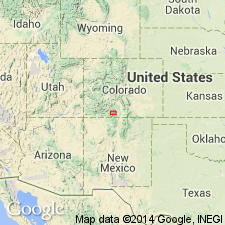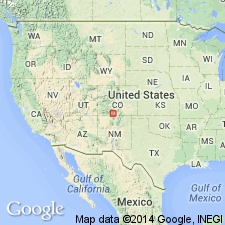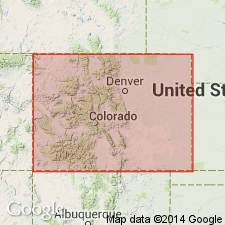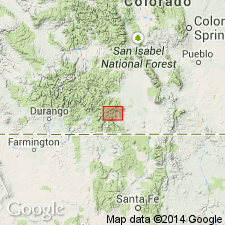
- Usage in publication:
-
- Ra Jadero Member*
- Modifications:
-
- Named
- Dominant lithology:
-
- Quartz latite
- AAPG geologic province:
-
- San Luis basin
Summary:
Named as a member of Treasure Mountain Tuff for exposures in Ra Jadero Canyon, its type locality, at 37 deg 14 min N, 106 deg 16 min W, about 26 km southeast of Platoro, Conejos Co, CO in San Luis basin. Is a thin (15 m) widespread ash-flow sheet. Is dark-brown where densely welded, quartz latite. Is coextensive with the Ojito Creek Member (new) beneath. Is overlain by the tuff of Masonic Park. Has reversed magnetic polarity. Has not been dated. Probably no more than 1 m.y. younger than the newly named La Jara Canyon Member (29.8 m.y.) beneath the Ojito Creek of the Treasure Mountain. Of Oligocene age.
Source: GNU records (USGS DDS-6; Denver GNULEX).

- Usage in publication:
-
- Ra Jadero Member*
- Modifications:
-
- Principal reference
- Dominant lithology:
-
- Tuff
- AAPG geologic province:
-
- San Luis basin
Summary:
Principal reference section selected [but not described] in cliff exposures along the lower Alamosa River Canyon, southwest of Chiquita Peak in secs 24 and 25, T36N, R6E, Conejos Co, CO in the San Luis basin. Is a thin (10-40 cm) widespread unit, one of six members of the Treasure Mountain Tuff erupted from the Summitville caldera. Usually rests on one of the older members of the Treasure Mountain. Usually overlain by Masonic Park Tuff, or Los Pinos or basalt of Hinsdale Formation. Composed of dark red-brown densely welded tuff underlain by basal black vitrophyre. Is heterogeneous in appearance but uniform in chemical composition. Age bracketed by radiometric dates of 29.8 and 29.1 m.y. Has reverse remanent magnetic polarity.
Source: GNU records (USGS DDS-6; Denver GNULEX).

- Usage in publication:
-
- Ra Jadero Member*
- Modifications:
-
- Areal extent
- Overview
- AAPG geologic province:
-
- San Luis basin
- San Juan basin
- San Juan Mountains province
Summary:
Ra Jadero Member, upper member of the Treasure Mountain Tuff. Areal extent of Ra Jadero in southwestern Colorado shown on distribution map; present in Mineral County (San Juan Mountain province), Rio Grande and Conejos Counties (San Luis basin), and Archuleta County (San Juan basin). Is co-extensive with the older Ojito Creek Member of Treasure Mountain. Is composed of quartz latite. Is associated with the Summitville caldera. Had an estimated volume of 100 to 500 cubic km. Age is more than 29.1 m.y. and less than 29.8 m.y.
Source: Modified from GNU records (USGS DDS-6; Denver GNULEX).

- Usage in publication:
-
- Ra Jadero Tuff*
- Modifications:
-
- Revised
- AAPG geologic province:
-
- San Juan Mountains province
- San Juan basin
- San Luis basin
Summary:
Rank raised to a tuff of the Treasure Mountain Group (rank raised). Study area is within southeastern San Juan volcanic field, Archuleta (San Juan basin), Mineral (San Juan Mountain province), and Rio Grande and Conejos (San Luis basin) Cos, CO. Is relatively thin but widespread ash-flow sheet of densely welded silicic dacite. Estimated volume is 150 cubic km (table 1). Distribution is similar to those of underlying tuffs. Rank raised because unit is as voluminous as some tuff sheets designated as formations elsewhere in San Juan volcanic field. Lipman (1975) considered source of tuffs to be Summitville caldera; however, present work weakens evidence for Summitville, instead source may be Platoro complex. Younger than middle tuff of Treasure Mountain; older than South Fork Tuff (new) of Treasure Mountain. Ar-Ar date of 28.76 Ma (Oligocene) (table 1).
Source: GNU records (USGS DDS-6; Denver GNULEX).
For more information, please contact Nancy Stamm, Geologic Names Committee Secretary.
Asterisk (*) indicates published by U.S. Geological Survey authors.
"No current usage" (†) implies that a name has been abandoned or has fallen into disuse. Former usage and, if known, replacement name given in parentheses ( ).
Slash (/) indicates name conflicts with nomenclatural guidelines (CSN, 1933; ACSN, 1961, 1970; NACSN, 1983, 2005, 2021). May be explained within brackets ([ ]).

